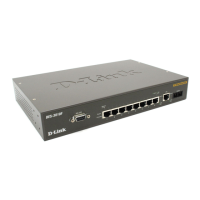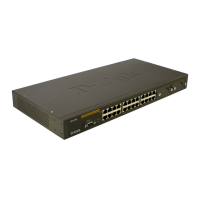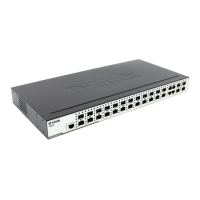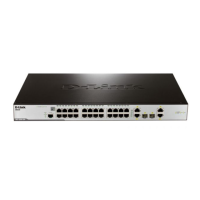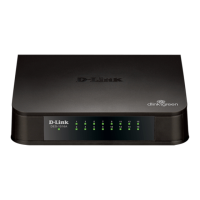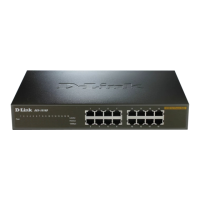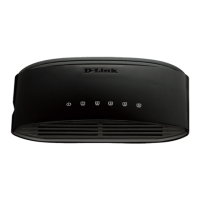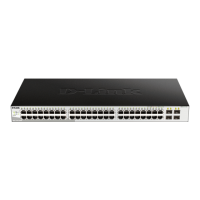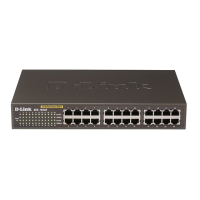


Do you have a question about the D-Link DES-3010G and is the answer not in the manual?
Lists precautions to reduce risks of injury, electrical shock, fire, and equipment damage.
Provides safety guidelines for installing and handling rack-mountable equipment.
Explains how to prevent static damage to electronic components during handling.
Describes using a web browser for switch configuration and monitoring.
Details accessing the switch via a serial console port for command-line management.
Explains how to set up user accounts and secure the switch with passwords.
Details SNMP versions, trap configurations, user tables, view tables, group tables, and community tables.
Describes how to assign an IP address to the switch for network communication and management.
Provides instructions on accessing the switch's web management interface using its IP address.
Allows configuration of individual port attributes like state, speed, and duplex mode.
Manages user privileges by creating, modifying, or deleting user accounts.
Details SNMP settings, trap configurations, user tables, view tables, group tables, and community tables.
Restricts switch access to authorized users by binding IP addresses to MAC addresses.
Covers configuring unicast forwarding, multicast forwarding, and multicast filtering.
Explains Virtual Local Area Networks, their benefits, and IEEE 802.1Q VLAN implementation.
Describes Link Aggregation and Port Trunk Groups for combining multiple ports into a single high-bandwidth link.
Details how IGMP snooping helps manage multicast traffic by recognizing IGMP queries and reports.
Explains 802.1d STP and 802.1w Rapid STP, including port states and compatibility.
Monitors and controls network traffic to prevent packet storms and ensure switch performance.
Locks MAC addresses to prevent unauthorized devices from connecting to switch ports.
Implements IEEE 802.1x standard for authorizing and authenticating network access.
Lists precautions to reduce risks of injury, electrical shock, fire, and equipment damage.
Provides safety guidelines for installing and handling rack-mountable equipment.
Explains how to prevent static damage to electronic components during handling.
Describes using a web browser for switch configuration and monitoring.
Details accessing the switch via a serial console port for command-line management.
Explains how to set up user accounts and secure the switch with passwords.
Details SNMP versions, trap configurations, user tables, view tables, group tables, and community tables.
Describes how to assign an IP address to the switch for network communication and management.
Provides instructions on accessing the switch's web management interface using its IP address.
Allows configuration of individual port attributes like state, speed, and duplex mode.
Manages user privileges by creating, modifying, or deleting user accounts.
Details SNMP settings, trap configurations, user tables, view tables, group tables, and community tables.
Restricts switch access to authorized users by binding IP addresses to MAC addresses.
Covers configuring unicast forwarding, multicast forwarding, and multicast filtering.
Explains Virtual Local Area Networks, their benefits, and IEEE 802.1Q VLAN implementation.
Describes Link Aggregation and Port Trunk Groups for combining multiple ports into a single high-bandwidth link.
Details how IGMP snooping helps manage multicast traffic by recognizing IGMP queries and reports.
Explains 802.1d STP and 802.1w Rapid STP, including port states and compatibility.
Monitors and controls network traffic to prevent packet storms and ensure switch performance.
Locks MAC addresses to prevent unauthorized devices from connecting to switch ports.
Implements IEEE 802.1x standard for authorizing and authenticating network access.
| Switching Capacity | 20 Gbps |
|---|---|
| MAC Address Table | 8K entries |
| RAM | 64 MB |
| Forwarding Rate | 14.8 Mpps |
| Dimensions | 440 x 44 x 220 mm |
| Power Supply | Internal power supply, 100-240V AC, 50/60Hz |
| VLANs | 802.1Q VLAN tagging |
| Spanning Tree Protocol | IEEE 802.1D |
| Quality of Service (QoS) | 802.1p |
| Management | Web-based GUI, SNMP |
| Jumbo Frame Support | Up to 9KB |
